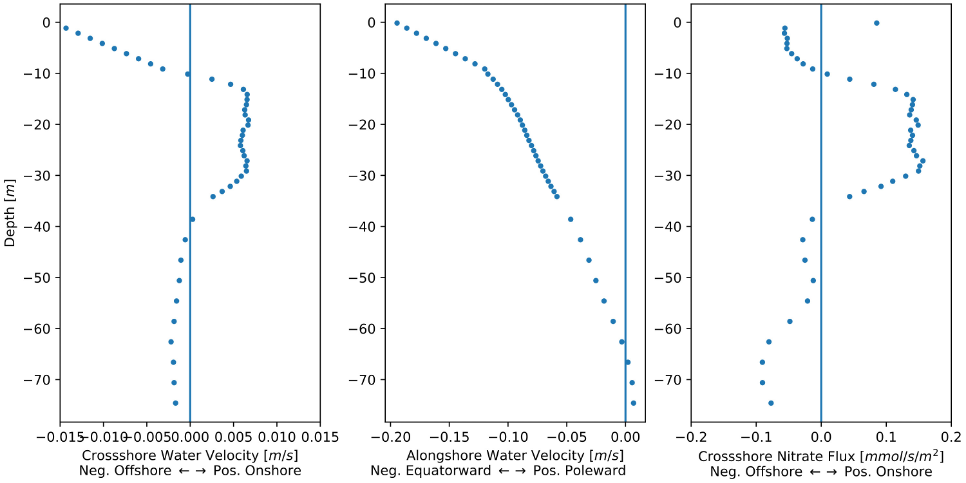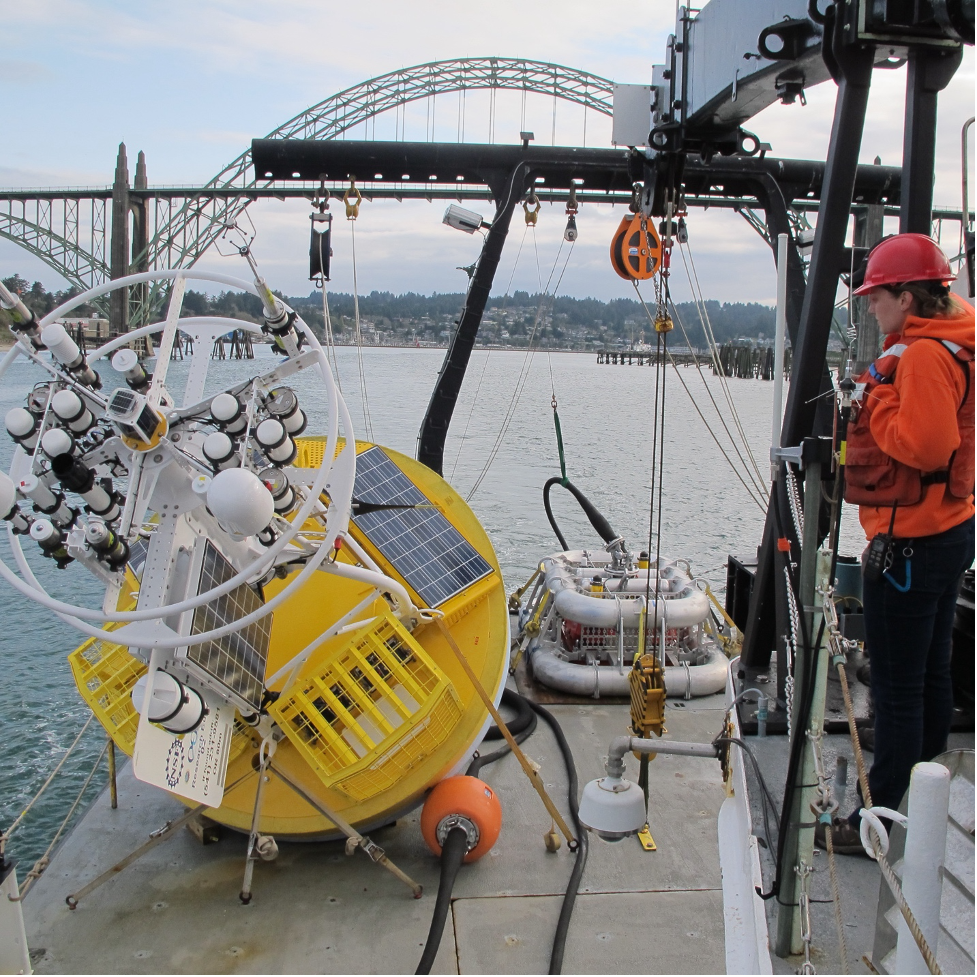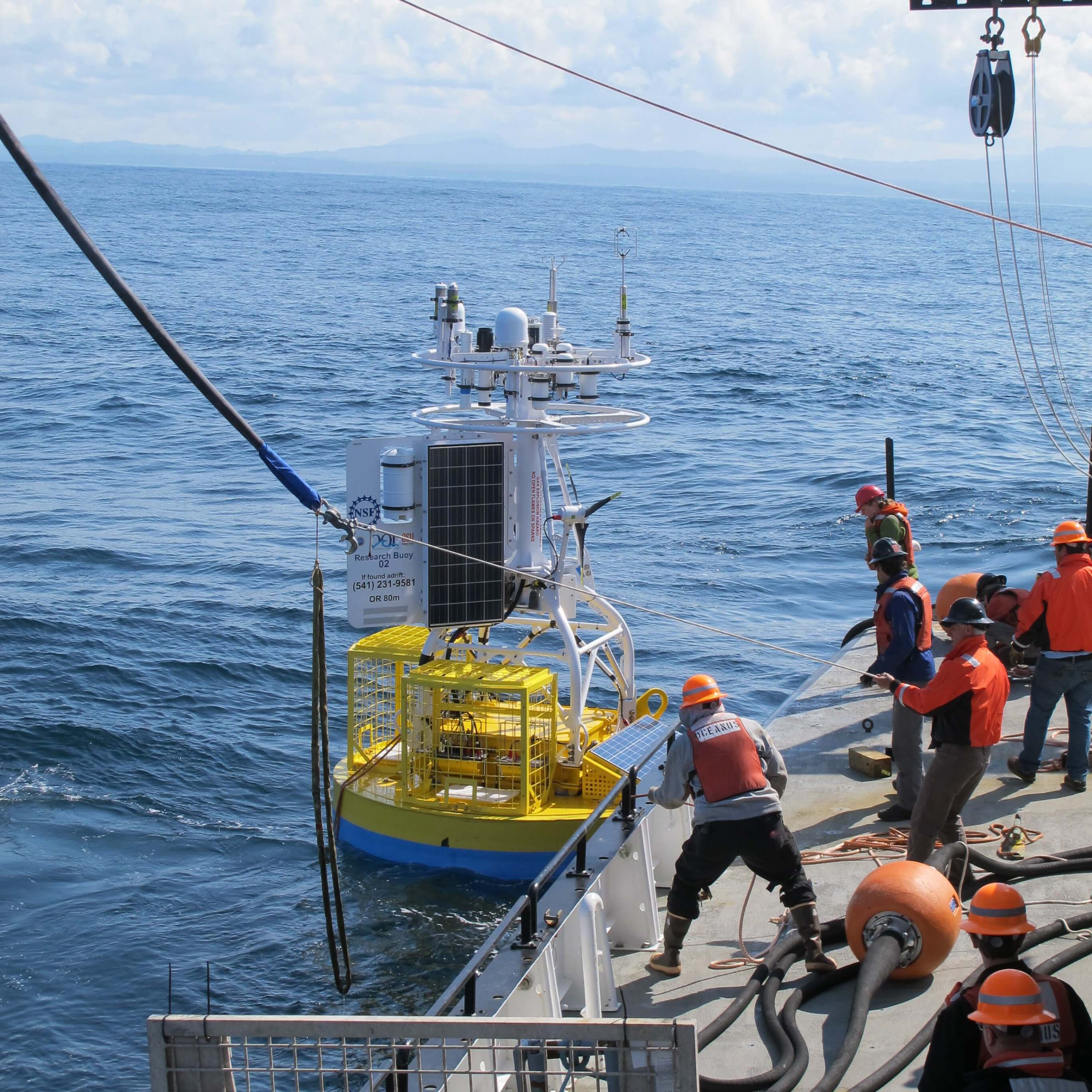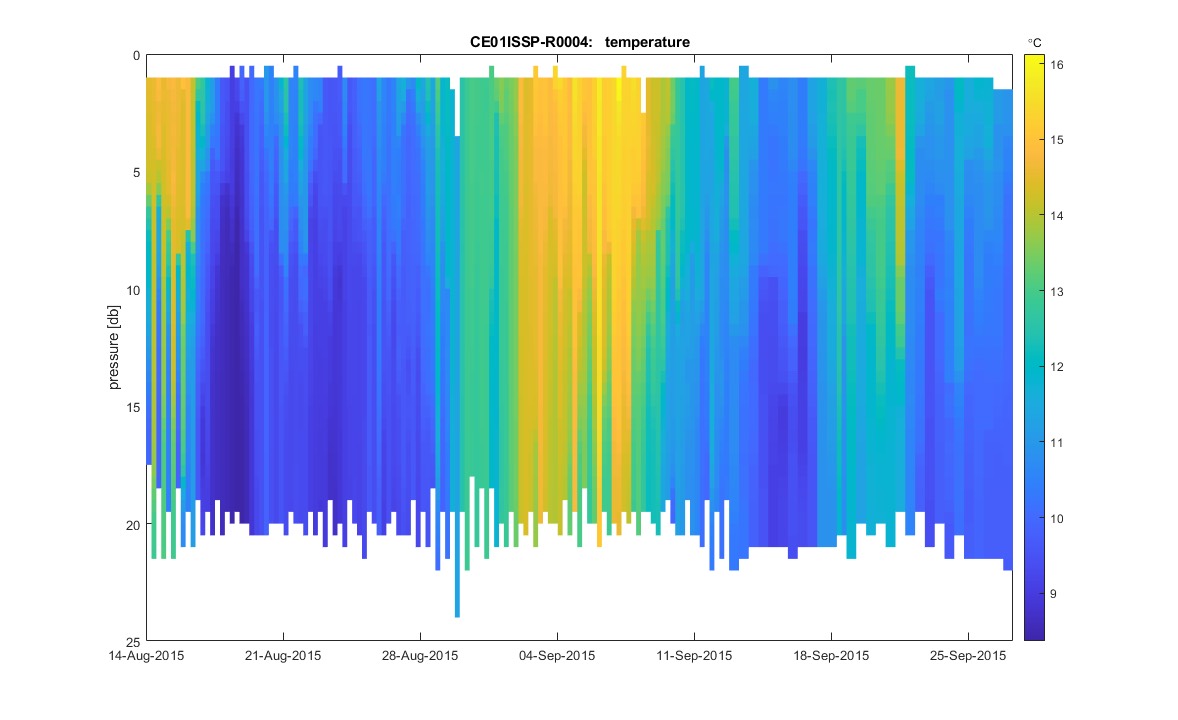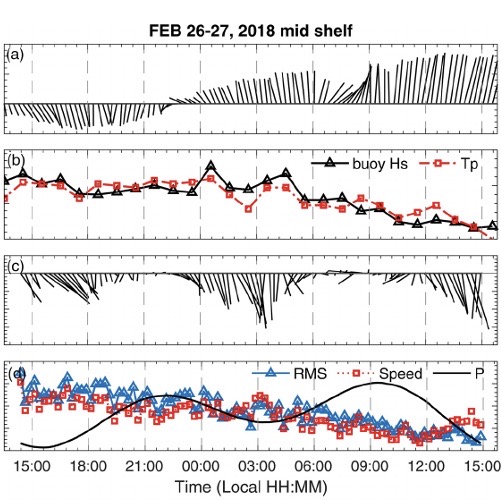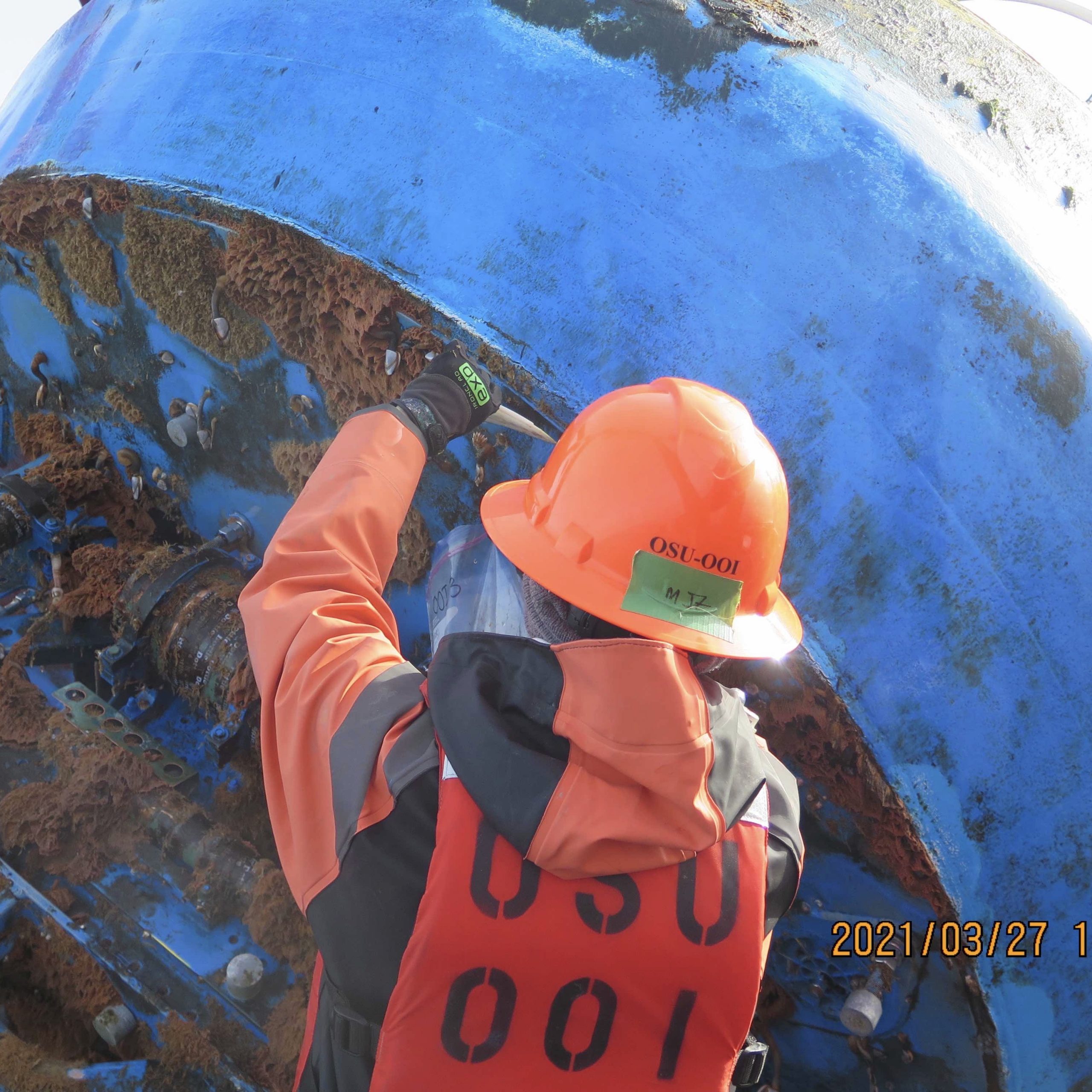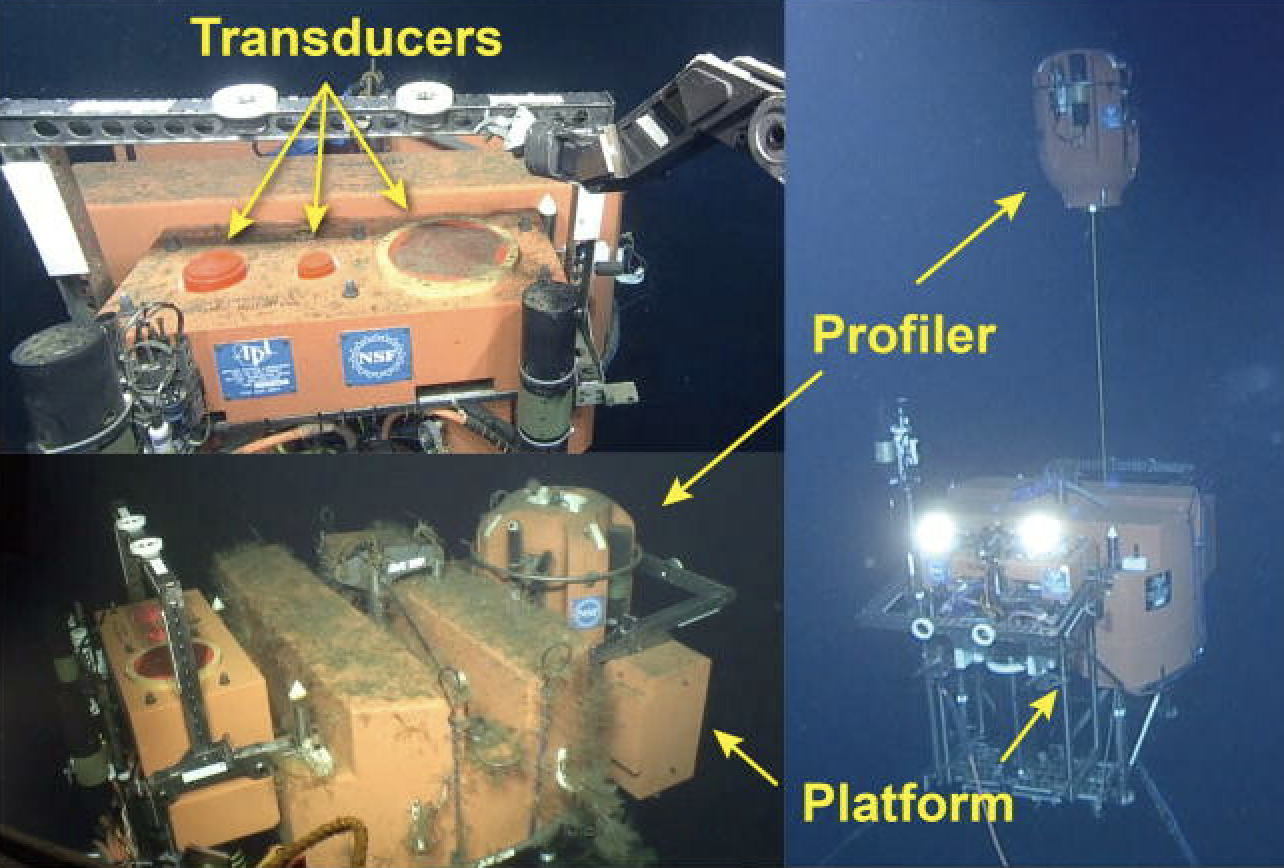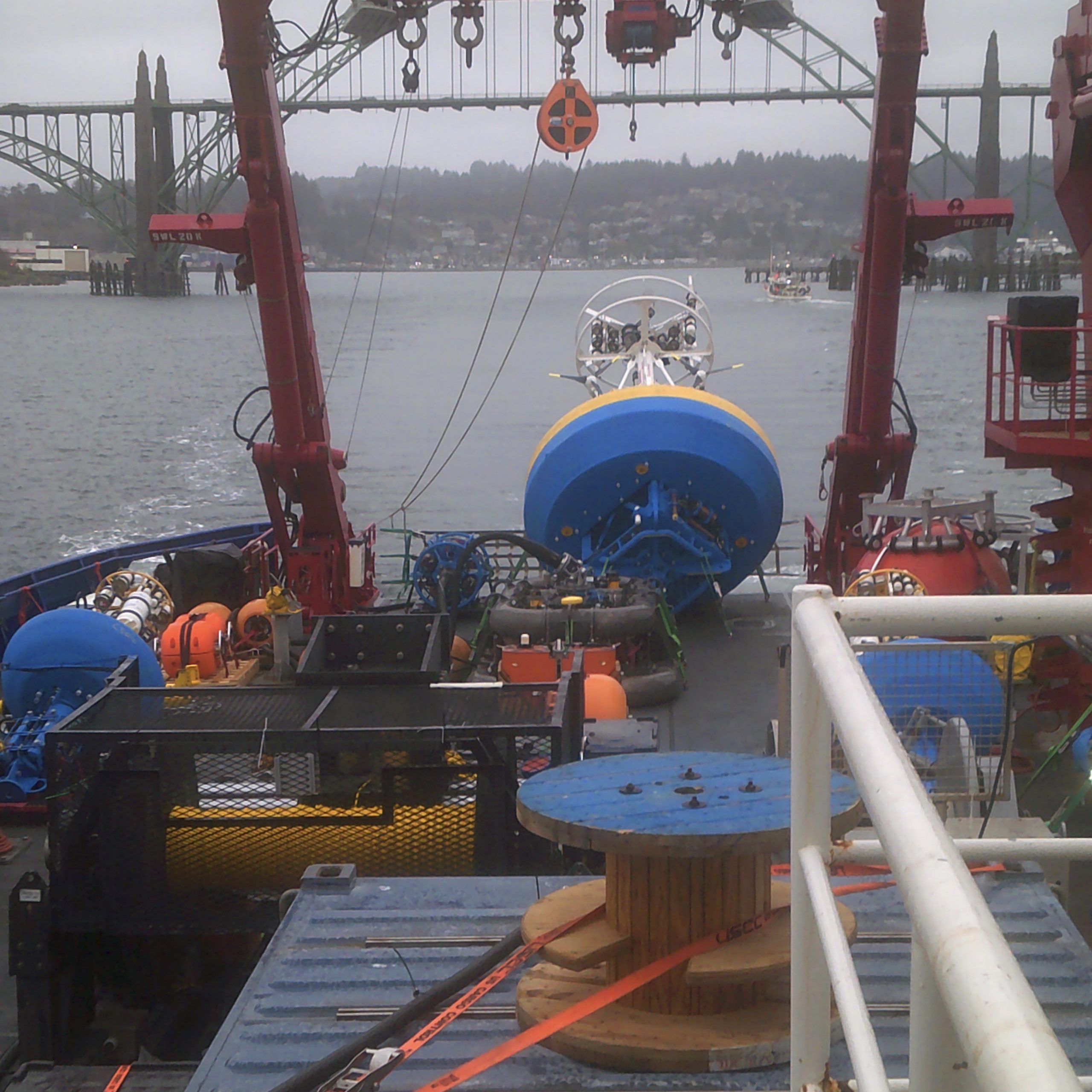Posts Tagged ‘Endurance Array’
Observations of Cross-Shelf Nitrate Fluxes over the Oregon Continental Shelf
Extracted from OOI Quarterly Report, 2022.
The US Pacific Northwest coastal ecosystems are primarily limited in growth from nitrate supply. The nitrate supply that drives the highly productive marine growth in this region is primarily a result of wind driven coastal upwelling. This work seeks to investigate cross-shelf nitrate fluxes over the continental shelf off the coast of Oregon following the installation of new nitrate and Acoustic Doppler current profilers (ADCPs) in the Ocean Observatories Initiative Coastal Endurance Array.
[media-caption path="/wp-content/uploads/2022/02/Endurance.png" link="#"]Figure 24. A velocity and nitrate profile from the shelf site at the Newport line. Data used was from the 2019 summer, approximately mid-June to early October (deployments 13, 14, and 15). The net nitrate flux found at that site over this time period, found by vertically integrating the values above, is roughly 1.16 mmol Nitrate/second/meter coastline. [/media-caption]
The primary onshore flow of nitrate-rich water over the continental shelf is found to originate at the middle depths, consistent with previous research in the region. However, the upwelling and cross-shelf nitrate fluxes on the continental shelf are found to be in poor agreement with common upwelling indices, e.g., coastal upwelling transport index (CUTI) and biologically effective upwelling transport index (BEUTI). Several factors for this disagreement are proposed, including the focus of the indices on dynamics farther offshore of the continental shelf. Observed coastal wind stress, calculated on a weekly rolling average, is found to be a potential alternative for predicting nearshore nitrate concentrations. Farther offshore at the mid-shelf, only a weak correlation between observed wind stress and observed surface transport is found, suggesting the need for additional dynamics to fully explain the observed surface transport and nitrate fluxes. Correctly modelling the nitrate supply for coastal ecosystems is essential for predicting phytoplankton blooms that are vital to the production of fisheries on the coast. Thus, understanding these limitations is of great importance for ocean-driven coastal economies.
Written by Andrew Scherer, California State University, Monterey Bay and Cleveland State University and Thomas Connolly, Moss Landing Marine Laboratories, San José State University
Andrew Scherer is an undergraduate physics student at Cleveland State University. In summer 2021, he performed this research with Prof. Tom Connolly (MLML, SJSU) as part of a National Science Foundation Research Experience for Undergraduates program and presented it at the Eastern Pacific Ocean Conference Stanford Sierra Center, Fallen Leaf Lake, California 26-29 Sep 2021.
Read MoreR/V Oceanus Remembered as a Workhorse of the U.S. Academic Research Fleet
The long service of the R/V Oceanus (1976-2021) came to end on November 21, 2021 as the ship pulled into port after having successfully completed its last interdisciplinary cruise for Oregon State University (OSU). The Oceanus began its 45-year-run of scientific investigations at Woods Hole Oceanographic Institution (WHOI) in 1976. After a major mid-life refit, the ship was transferred to OSU in 2012, and contributed to the Ocean Observatories Initiative (OOI) off both coasts.
“The Oceanus proved to be a real workhorse for the Academic Research Fleet and also played a pivotal role for the OOI during its initial launch,” said Ed Dever, PI of OOI’s Coastal Endurance Array, who sailed on the ship many times. “While at WHOI, The Oceanus performed some of OOI’s at-sea-mooring test deployments and later the ship was used for the initial deployment of the Coastal Endurance Array off the Oregon coast.”
In spring and fall 2014, after moving to OSU, Oceanus performed the initial deployments of the Oregon and Washington inshore moorings and Washington profiler mooring. The real test for the Oceanus, however, came during 2015, when it was tasked with deploying the full scope of the Endurance Array, including the four large coastal surface moorings at the Oregon and Washington shelf and offshore sites.
Explained Dever, “Thanks to some excellent ship handling, care on the part of the deck crew and a huge assist from some very kind weather, we got the moorings safely in the water using the ship’s crane to deploy the 10,000-pound buoy off the starboard fantail and the heavy lift winch to deploy the 11,000-pound multifunction node (MFN, bottom lander) through the A-frame. The size of the buoys and MFNs meant that Oceanus could only carry one buoy out at a time and the cruise was completed in five legs with some very efficient port stops. By the end of the cruise, it was evident that we would need to move future operations to global and oceans class ships and after one more deployment in fall 2015 (with recoveries carried out on the R/V Thomas G. Thompson), we made that transition.”
[embed]https://youtu.be/pDRagMTDUTk[/embed]After the initial Endurance Array deployments, OOI transitioned to using larger global and oceans class ships needed to recover the bulky coastal surface moorings, with one exception. In spring 2019, with tight schedules on global class ships, UNOLS (University-National Oceanographic Laboratory System charged with ship scheduling) requested that OOI Endurance split the spring mooring recovery and deployment cruise between the R/V Sikuliaq and the R/V Oceanus. The Oceanus ably performed the profiler mooring deployment, anchor recoveries, coastal surface piercing profiler deployments, and glider deployments over five days in April and May 2019.
While not directly working with the OOI, the Oceanus continued to work off Oregon at and around the OOI arrays. Research and student cruises often sampled over the years near OOI’s Endurance and RCA Arrays at the Oregon inshore, shelf, offshore and Hydrate Ridge sites to compare shipboard measurements and OOI time series. This work included CTD profiles, net tows, coring, and sediment trap deployments.
The last Oceanus cruise, in fact, was one such interdisciplinary research cruise led by OSU researcher Clare Reimers, who also served as chief scientist. During its final official outing, the team aboard the Oceanus sampled the outer shelf at the northern end of Heceta Bank, Oregon to help scientists determine any changes that may have occurred to a swath of the margin that was reopened to commercial bottom trawling in 2020 after an 18-year closure. Reimers said, “The R/V Oceanus and crew performed flawlessly, and our science mission was fully completed.”
Added Dever, “What better way to end its long and illustrious career? We at OOI join many others in appreciation of the R/V Oceanus, and the dedication and skills of all who sailed on her and supported ocean science throughout her many years at sea.”
______________________________________________________________________________________
Special thanks to OOI Data Center Project Manager Craig Risien for sharing the GoPro time lapse of the loading of the Oregon Offshore mooring onto the R/V Oceanus in spring 2015.
Read MoreEndurance Array to Provide Hourly Meteorological Data
On 11 October 2021, the National Oceanic and Atmospheric Administration (NOAA)requested that OOI’s Coastal Endurance Array buoys provide hourly meteorological data to the National Data Buoy Center (NDBC) because a nearby NDBC buoy (46029, Columbia River bar) had gone offline. OOI buoy data are typically telemetered every two hours due to sampling schedule and bandwidth constraints (the actual sampling rate is higher).
Endurance Array team members examined sampling and telemetry schedules for the Endurance offshore coastal surface moorings to see if they could accommodate NOAA’s request. The team concluded that meteorological data from the moorings could be updated hourly while still meeting OOI sampling requirements.
“To help ensure continuity of data to the NDBC, we plan to distribute hourly meteorological data from the Endurance Array Oregon and Washington offshore sites for the duration of the outage at NBDC 46029,” said Edward Dever, lead of the Coastal Endurance Team. “We’re pleased to respond to NOAA’s request and hope these data prove useful to operational weather forecasts and marine safety.” The Oregon and Washington offshore sites have NDBC buoys designations of 46098 and 46100, respectively.
The Endurance Array team will continue to review the performance of the buoys and ensure the updated telemetry schedule does not impact OOI sampling. If data users do experience any impacts from this change in sampling frequency, please contact Jon Fram at Jonathan.Fram@oregonstate.edu.
Read MoreNew Underwater Camera with Off-the-Shelf Components
In September 2021, the Coastal Endurance Array began rolling out a much-needed upgrade to their underwater cameras. Endurance Array Innovator Chris Holm engineered a camera using off-the-shelf components to meet the specific needs of capturing environmental conditions and marine life in proximity to the Endurance Array moorings. The prototype was put in place on the inshore mooring (CE01) during the 15th turn of the Coastal Endurance Array.
[media-caption path="https://oceanobservatories.org/wp-content/uploads/2021/10/camera.png" link="#"]The newly configured Endurance Array underwater camera is attached to the inshore mooring, ready for deployment. Photo: Chris Holm, OSU.[/media-caption]The innovation came in multiple steps. Holm first tried to salvage the camera’s hardware and reprogram the camera with new software. He hit a snag, however, in that the motherboard that controlled the camera was no longer supported.
Since it didn’t make sense to rebuild the camera using an out-of-date motherboard, Holm looked into finding a new camera on the market. It had to be suitable for use underwater, with the capability to go into a low-power mode. “What is really needed for low-light conditions underwater is a camera with a large physical sensor, but with fewer megapixels,” explained Holm.
“Since the moorings run on battery power, the cameras need to be able to go into a very low-power sleep state in between taking photos,” said Holm. “If the sleep current is high, the deployment life is low. So, we were trying to find an off-the-shelf solution for a way to go into low power.”
After some searching, Holm obtained a Raspberry Pi High Quality Camera. Although the Raspberry Pi doesn’t come with native power management capabilities, Holm found he could use Sleepy Pi, an add-on-board from Spell Foundry that can power the Raspberry Pi on and off.
For its launch, the camera is programmed to autonomously take a burst of three images every four hours. The system can also take photos when triggered by a Data Concentration Logger (DCL) and can be partially configured remotely. Future iterations will be fully configurable remotely via the DCL.
The final touch to this first iteration was figuring out how to turn the lights and lasers on and off. Holm used a relay board from Waveshare Electronics to power the original systems lights and lasers. The lights adjust their brightness depending on the voltage being sent through a signal line which is controlled by the GPIO pins of the Raspberry Pi.
Altogether, the system is very suitable for the Endurance Array’s needs and is an extremely cost-effective, off-the-shelf solution. The cameras also can be easily swapped out if the Endurance team decides to upgrade the cameras.
Since this newly configured camera was put in place in early September, Holm said, it has been performing flawlessly, with the auto-exposure working well. Since this mooring uses a cell modem to transmit data, the team has been able to see the photos the camera is taking in near real-time. Once the formal approval process for the camera’s integration and use across the OOI is completed, Holm will be building more camera systems for the Endurance Array to deploy on the offshore and shelf moorings during the spring.
Since the cameras and its settings can be upgraded and/or optimized for different use cases, depending on what an investigator is interested in (such as marine snow or benthic organisms), Holm would like to hear from scientists about what they’d like the camera to focus on. He created a survey for data users interested in the underwater cameras.
“It would be very helpful to know what kind of data would be most useful to scientists using the system,” he said.
For those interested in seeing underwater, please complete the survey here.
[media-caption path="https://oceanobservatories.org/wp-content/uploads/2021/10/camera-output.png" link="#"]The Endurance Array team has the capability to adjust the settings of the underwater cameras based on researchers’ interests. In addition, some post-processing tools could be developed to sort images or extract useful information from them. Photo: Chris Holm, OSU.[/media-caption]
Read More
Tackling Sea Surface Sampling Issues
The sea surface is the hardest place to work, according to Jonathan Fram, Project Manager of the Coastal Endurance Array. That’s because at the surface, waves are constantly sloshing around. At any time, a large wave can tug on mooring winch lines, creating sudden tension, which can wear down cables and even cause them to break.
Scuba divers know that surface waters are rough, but below a certain depth—about one wave orbital below the surface—the waters calm significantly. Unfortunately, a lot of great science takes place at the surface, so it’s important for sampling instruments like the Coastal Surface Piercing Profiler (CSPP) to be able to withstand the waves at and near the surface. Fortunately, OOI engineers have found ways to meet the many challenges of working in this rough environment.
“The Coastal Endurance Array Team has made changes to the CSPP to make it more robust, so that we can get the kind of continuous time series that are so valuable to scientists,” said Fram.
A CSPP spends most of its time near the sea floor, but either two or four times a day, the profiler winches itself up to the surface, taking samples as it ascends. Once it reaches the surface, the profiler sends its data back to shore and then quickly returns to the safety of the seafloor. Profilers are important ocean observatory tools because they can help capture what is happening at certain depths where stationary instruments aren’t present. “We’ve had times where you get a persistent chlorophyll bloom at a certain depth where there is zero mooring data,” explained Fram. “So the CSPP sampling is needed to make sense of what’s happening. It’s impossible to have all the instruments at all depths. The CSPP fills in this gap.”
Last year, the Coastal Endurance Array team reviewed their activities looking for ways to reduce lost time at sea. One thing they discovered was that the anchor systems of the CSPPs were unreliable. To deal with this problem, the team created a new kind of anchor. The old profiler anchors had a chain between the profiler and anchor that helped dampen the waves so that the device was not tugged on when resting in between profiles. The chain, however, made it difficult to deploy the anchor in an upright position. Anchors need to be deployed upright so their recovery floats can be acoustically released. The team redesigned the anchors so they now behave like a weeble wobble toy that is weighted so it always rights itself. This new design makes it hard to deploy an anchor upside down, making the anchors more reliable.
The team also made updates to the modems that send data to shore. When the CSPP is at the surface, the winch must stay on because it keeps the antenna vertical. This time-on takes up about a quarter of the battery power. To reduce the power demand, the team switched out some of the iridium modems for cellular modems, which has allowed the CSPPs to send data more quickly. A faster modem means that the profiler spends less time at the surface, not only saving power, but reducing the risk of being damaged by a large wave. The team is currently working on upgrading to faster cellular modems that can connect further from shore.
“At the same time we are making these updates on the Oregon Shelf Mooring, we’re also implementing them on the Washington Shelf Mooring,” said Fram. “So an improvement on one platform is also leading to an improvement on another platform.”
A third innovation involves improvements to the batteries.
“When waves tug on the winch, it goes from being a power sink to a power source. That sometimes creates power spikes that can fry the connectors. So we’ve rewired the batteries to make them more robust,” explained Fram. The rewiring is expected to reduce the number of power failures and keep the CSPPs running continuously. “Since April when we first started using the rewiring scheme, we’ve had four profilers in the water with no problems for six weeks,” said Fram.
The team also is in the process of replacing batteries that power the profiler with their own design of rechargeable batteries. While OOI engineers prefer to use commercially available parts for easier repair and replacement, when parts on the market don’t fit their needs, they design their own. The new batteries will be more reliable than those they are replacing. The newly designed batteries will also be deployed on the wire-following profilers on the Coastal Pioneer Array.
“My focus is on making all of the Coastal Endurance instrumentation work,” said Fram. “When we’re able to get a full three months’ deployment through the winter, through super rough seas, that makes my day. Making improvements is what I look forward to the most.”
Read MoreBottom Boundary Layer O2 Fluxes During Winter on the Oregon Shelf
Adapted and condensed by OOI from Reimers et al., 2022, doi:/10.1029/2020JC016828.
[caption id="attachment_21037" align="aligncenter" width="640"]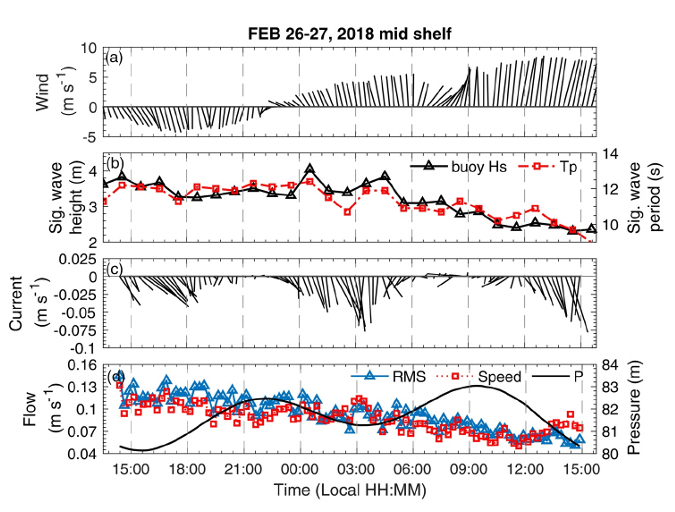 Fig. 1 Time series of physical conditions during the February 26–27, 2018 deployment (EC D1) at the mid-shelf site. (a) Wind vectors (15-min averages) measured at the OOI Shelf Surface Mooring (CE02SHSM), (b) wave properties (hourly averages) measured at the OOI Shelf Surface Mooring, (c and d) other near-bottom ADV parameters (15-min averages). Both the winds and ADV velocities are portrayed in earth coordinates (eastward is to the right along the horizontal axis and northward is positive along the vertical axis). ADV, Acoustic Doppler Velocimeter; EC D, eddy covariance deployment[/caption]
Fig. 1 Time series of physical conditions during the February 26–27, 2018 deployment (EC D1) at the mid-shelf site. (a) Wind vectors (15-min averages) measured at the OOI Shelf Surface Mooring (CE02SHSM), (b) wave properties (hourly averages) measured at the OOI Shelf Surface Mooring, (c and d) other near-bottom ADV parameters (15-min averages). Both the winds and ADV velocities are portrayed in earth coordinates (eastward is to the right along the horizontal axis and northward is positive along the vertical axis). ADV, Acoustic Doppler Velocimeter; EC D, eddy covariance deployment[/caption]
The oceanic bottom boundary layer (BBL) is the portion of the water column close to the seafloor where water motions and properties are influenced significantly by the seabed. This study (Reimers & Fogaren, 2021) reported in the Journal of Geophysical Research examines conditions in the BBL in winter on the Oregon shelf. Dynamic rates of sediment oxygen consumption (explicitly oxygen fluxes) are derived from high-frequency, near-seafloor measurements made at water depths of 30 and 80 meters. The strong back-and-forth motions of waves, which in winter form sand ripples, pump oxygen into surface sediments, and contribute to the generation of turbulence in the BBL, were found to have primed the seabed for higher oxygen uptake rates than observed previously in summer.
Since oxygen is used primarily in biological reactions that also consume organic matter, the winter rates of oxygen utilization indicate that sources of organic matter are retained in, or introduced to, the BBL throughout the year. These findings counter former descriptions of this ecosystem as one where organic matter is largely transported off the shelf during winter. This new understanding highlights the importance of adding variable rates of local seafloor oxygen consumption and organic carbon retention, with circulation and stratification conditions, into model predictions of the seasonal cycle of oxygen.
Supporting observations, which give environmental context for the benthic eddy covariance (EC) oxygen flux measurements, include data from instruments contained in OOI’s Endurance Array Benthic Experiment Package and Shelf Surface Moorings. Specifically, velocity profile time-series are drawn from records of a 300-kHz Velocity Profiler (Teledyne RDI-Workhorse Monitor), near-seabed water properties from CTD (SBE 16plusV2) and oxygen (Aanderaa-Optode 4831) sensors, winds from the surface buoy’s bulk meteorological package, and surface-wave data products from a directional wave sensor (AXYS Technologies) (see e.g., Fig 1 above).
Reimers, C. E., & Fogaren, K. E. (2021). Bottom boundary layer oxygen fluxes during winter on the Oregon shelf. Journal of Geophysical Research: Oceans, 126, e2020JC016828. https://doi.org/10.1029/2020JC016828
Read More
Mission Accomplished: Endurance 14 Cruise Meets All Objectives
After a 15-day expedition, the Endurance Array Team returned to port aboard the R/V Sikuliaq on 7 April having successfully completed the 14th turn of the Endurance Array. The team recovered and deployed seven surface moorings and completed sampling at all recovery/deployment sites. They also deployed and recovered gliders and surface profilers.
Because of the size and weight of the moorings and other equipment, the trip was conducted in two legs. The first leg was primarily off Washington and the second off Oregon. Between legs, the R/V Sikuliaq returned to Newport, Oregon to offload recovered equipment from the Washington Line and load new equipment for the Oregon Line.
The weather was rough when the R/V Sikuliaq first set off from Newport on 24 March. On the first night out, they saw 19-foot waves and 35-knot winds. The team worked around the weather on the first leg to deploy three moorings and recover four. They also recovered and deployed gliders.
The second leg of the journey brought with it much better weather, which eased the recoveries, deployments, sampling, and other activities. During this leg, the team worked mostly off Oregon. The team deployed four moorings and three profilers and recovered three moorings, three gliders, and a profiler.
Each OOI deployment brings some technical improvement. On this deployment, the Endurance moorings are outfitted with redesigned solar panels on the buoy decks. These panels will deliver more power and be more resilient to wear and tear caused by sea lions who often find the buoys an inviting place to lounge. The redesign was implemented by OOI’s Coastal and Global Scale Nodes team at Woods Hole Oceanographic Institution.
This trip also marked the Endurance Array’s team first use of a OOI’s ROV (remotely operated vehicle). The ROV was used at the Oregon shelf site to recover a coastal surface piercing profiler and its anchor. Throughout the process, the R/V Sikuliaq maneuvered skillfully to place the ship over the target. Mooring lead Alex Wick piloted the ROV through strong currents and limited visibility. It took four dives, but the profiler and its anchor were recovered. On the third dive, the ROV was used to cut the winch line so the team could recover the profiler, and the anchor was recovered on the fourth and final dive.
The Endurance team also collected CTD samples and biofouling samples to share with researchers at the Smithsonian Institute and Oklahoma State University. The R/V Sikuliaq returned to Newport on 7 April with the recovered equipment, which will undergo refurbishment for the next turn of the Endurance Array in September.
“Since 2017, we’ve sailed on the R/V Sikuliaq for six out of nine cruises,” said Ed Dever, the Chief Scientist of Endurance 14. “It’s a match that works well. From ship handling and on-deck assistance to mobilization of underway science sensors, lifting gear, engineering, accommodations, and food, we are deeply appreciative of the Sikuliaq’s captain, crew, and the ship herself.”
Read MoreA Bountiful Sea of Data: Making Echosounder Data More Useful
[media-caption path="https://oceanobservatories.org/wp-content/uploads/2021/03/Screen-Shot-2021-03-30-at-5.51.41-PM.png" link="#"]Researchers used echosounder data from the Oregon Offshore site of the Coastal Endurance Array to develop a new methodology that makes it easier to extract dominant patterns and trends.[/media-caption]The ocean is like a underwater cocktail party. Imagine, as a researcher, trying to follow a story someone is telling while other loud conversations are in the background of a recording. This phenomenon, known as the “Cocktail Party Problem,” has been studied since the 1950s (Cherry, 1953; McDermott, 2009). Oceanographers face this challenge in sorting through ocean acoustics data, with its mixture of echoes from acoustic signals sent out to probe the ocean.
Oceanographer Wu-Jung Lee and data scientist Valentina Staneva, at the University of Washington, teamed up to tackle the challenge in a multidisciplinary approach to analyze the vast amounts of data generated by echosounders on Ocean Observatories Initiative (OOI) arrays. Their findings were published in The Journal of the Acoustical Society of America, where they proposed a new methodology that uses machine learning to parse out noisy outliers from rich echosounder datasets and to summarize large volumes of data in a compact and efficient way.
This new methodology will help researchers use data from long time series and extract dominant patterns and trends in sonar echoes to allow for better interpretation of what is happening in the water column.
The ocean is highly dynamic and complex at the Oregon Offshore site of the OOI Coastal Endurance Array, where echosounder data from a cabled sonar were used in this paper. At this site, zooplankton migrate on a diurnal basis from a few hundred meters to the surface, wind-stress curl and offshore eddies interact with the coastal circulation, and a subsurface undercurrent moves poleward. The echosounder data offer opportunities to better understand the animals’ response to immediate environmental conditions and long-term trends. During the total eclipse of the Sun in August 2017, for example, echosounders captured the zooplankton’s reaction to the suddenly dimmed sunlight by moving upwards as if it was dusk time for them to swim toward the surface to feed (Barth et al, 2018).
Open access of echosounder datasets from the OOI arrays offers researchers the potential to study trends that occur over extended stretches of time or space. But commonly these rich datasets are underused because they require significant processing to parse out what is important from what is not.
Echosounders work by sending out pulses of sound waves that bounce off objects. Based on how long it takes for the reflected echo to come back to the sensor, researchers can determine the distance of the object. That data can be visualized as an echogram, an image similar to an ultrasound image of an unborn baby.
But unlike an ultrasound of a baby, when an undersea acoustic sensor records a signal, it may be a combination of signals from different sources. For example, the signal might be echoes bouncing off zooplankton or schools of fish.
[caption id="attachment_20566" align="alignleft" width="350"] (A) Data used in this work were collected by a three-frequency echosounder installed on a Regional Cabled Array Shallow Profiler mooring hosting an underwater platform (200 m water depth) and profiler science pod located at the Oregon Offshore site of the OOI Coastal Endurance Array (red triangle). The symbols indicate the locations of all OOI echosounders installed along the coast of Oregon and Washington. (B) The transducers are integrated into the mooring platform (from left to right: 120, 200, and 38 kHz). The platform also hosts an instrumented profiler that traverses the water column above the echosounder from ~ 200 m to ~ 5m beneath the ocean’s surface. (Image credit: UW/NSF-OOI/WHOI-V15).[/caption]
(A) Data used in this work were collected by a three-frequency echosounder installed on a Regional Cabled Array Shallow Profiler mooring hosting an underwater platform (200 m water depth) and profiler science pod located at the Oregon Offshore site of the OOI Coastal Endurance Array (red triangle). The symbols indicate the locations of all OOI echosounders installed along the coast of Oregon and Washington. (B) The transducers are integrated into the mooring platform (from left to right: 120, 200, and 38 kHz). The platform also hosts an instrumented profiler that traverses the water column above the echosounder from ~ 200 m to ~ 5m beneath the ocean’s surface. (Image credit: UW/NSF-OOI/WHOI-V15).[/caption]
“When the scatterers are of different size, they will reflect the sound at different frequencies with different strengths,” said Lee. “So, by looking at how strong an echo is at different frequencies, you will get an idea of the range of sizes that you are seeing in your echogram.”
Current echogram analysis commonly requires human judgement and physics-based models to separate the sources and obtain useful summary statistics. But for large volumes of data that span months or even years, that analysis can be too much for a person or small group of researchers to handle. Lee and Staneva’s new methodology utilizes machine learning algorithms to do this inspection automatically.
“Instead of having millions of pixels that you don’t know how to interpret, machine learning reduces the dataset to a few patterns that are easier to analyze,” said Staneva.
Machine learning ensures that the analysis will be data-driven and standardized, thus reducing the human bias and replicability challenges inherently present in manual approaches.
“That’s the really powerful part of this type of methodology,” said Lee. “To be able to go from the data-driven direction and say, what can we learn from this dataset if we do not know what may have happened in a particular location or time period.”
Lee and Staneva hope that by making the echosounder data and analytical methods open access, it will improve the democratization of data and make it more usable for everybody, even those who do not live by the ocean.
In the future, they plan to continue working together and use their new methodology to analyze the over 1000 days of echosounder data from the OOI Endurance Coastal and Regional Cabled Array region.
References
Lee, W-J and Staneva, V (2021).Compact representation of temporal processes in echosounder time series via matrix decomposition. Special Issue on Machine Learning in Acoustics. The Journal of the Acoustical Society of America.
Barth JA, Fram JP, et al. (2018). Warm Blobs, Low-Oxygen Events, and an Eclipse: The Ocean Observatories Initiative Endurance Array Captures Them All.Oceanography, Vol 31.
McDermott, J (2009). The Cocktail Party Problem.Current Biology, Vol 19, Issue 22.
Cherry EC (1953). Some Experiments on the Recognition of Speech, with One and Two Ears.The Journal of the Acoustical Society of America. Vol. 25, No.5.
Read More
Spring Expeditions: Keeping OOI Arrays Fully Operational
OOI teams were in the water on opposite coasts in late March to service the Pioneer and Endurance Arrays. The teams will “turn” the moorings (recover old and deploy new) to keep the arrays continually collecting and reporting data back to shore. This is the 14th turn of the Endurance Array; the 16th for the Pioneer Array.
The Endurance 14 Team set sail from Newport Oregon aboard the R/V Sikuliaq on 24 March for a 15-day expedition. The Pioneer 16 Team departed from Woods Hole, MA, a few days later on 29 March aboard the R/V Armstrong for a 21-day mission. Both expeditions will require two legs because of the need to transport a huge amount of equipment. The equipment for the Pioneer Array weighs more than 129 tons. The Endurance equipment tops the scale at 95 tons.
Departures for both teams occurred after arranging for reduced occupancy on site and social distancing during preparation, followed by 14 days of quarantine to meet COVID-19 restrictions. And while onboard, COVID has necessitated other changes ranging from smaller science parties to scheduled meal times to allow for social distancing.
“It is very impressive that the OOI team has been able to continue to service these arrays in spite of the challenges presented by COVID,” said Al Plueddemann, Chief Scientist of the Pioneer 16 Expedition. “The ocean is a tough environment in which to keep equipment operational, even in normal times. This year, in particular, has required both our shore-based staff and those onboard to be adaptable, flexible, and innovative to get the job done.”
[media-caption path="https://oceanobservatories.org/wp-content/uploads/2021/03/burnin_Travis.jpg" link="#"]The full cycle of preparation for an OOI mooring service cruise takes many months. The “burn-in” period for Pioneer-16, during which equipment is assembled and tested, began in January 2021 with snow on the ground outside of the LOSOS building on the WHOI campus. Credit:Rebecca Travis © WHOI.[/media-caption]In addition to the mooring and deployment recoveries, both teams are deploying and recovering gliders that collect additional data within the water column and the area between the moorings. They also are conducting CTD casts and water sampling at the mooring sites, and doing meteorological comparisons between ship and buoys. The Pioneer Team will be operating autonomous underwater vehicles (AUVs), while the Endurance Team will have its inaugural use of OOI’s own remotely operated vehicle (ROV) to recover anchors at the Oregon shelf site.
“In normal times, we would invite external students and scientists along to conduct ancillary experiments on the cruise,” said Edward Dever, Chief Scientist for Endurance 14. “But given the limited science party allowed onboard due to COVID-19, the OOI team will be conducting some of this additional work to ensure the continuity of these experiments.”
For Endurance 14, this work includes collection of organisms that grow on panels attached to Endurance buoys for invasive species research, collection of settling organisms on devices attached to Multi-Function Nodes, which power near bottom data instruments, and test deployments of tagged fish acoustic monitors on near surface instrument frames on three moorings.
Likewise, the Pioneer 16 Team is helping ensure ongoing science investigations installing and operating unattended underway sampling for the Northeast U.S. Shelf Long-Term Ecological Research (LTER) project and conducting CTD casts at LTER sites during the cruise. They will also conduct communication tests at the Offshore mooring site in support of the Keck-funded 3-D Acoustic Telescope project.
Science teams of 9-10 people on each cruise are sharing the multitude of tasks needed for the moored array service.
[media-caption path="https://oceanobservatories.org/wp-content/uploads//2021/03/Screen-Shot-2021-04-01-at-9.19.20-AM.png" link="#"]OOI’s remotely operated vehicle will be used for the first-time during Endurance 14. Credit: Seaview Systems.[/media-caption]
Read More
Women Who Make OOI Happen
[gallery columns="5" ids="28710,28711,28712,28713,28714"]
Keeping OOI operational and providing data around the clock requires a whole team of people working behind the scenes. Because March is Women’s History Month, we have taken the opportunity to ask a few women to share their stories about coming to and working for OOI. By featuring women who contribute to OOI’s success, we honor those women, past and present, who have made OOI possible.
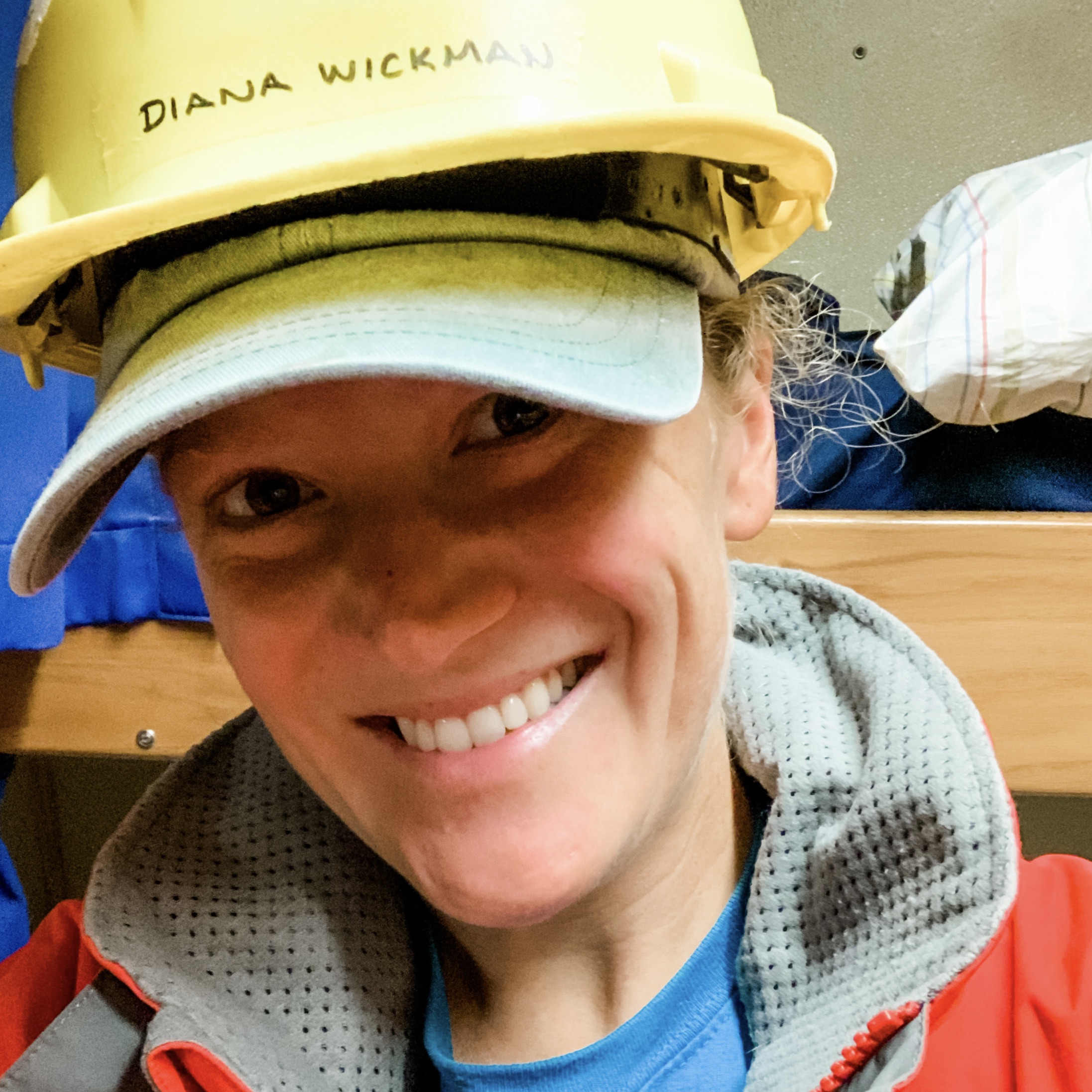
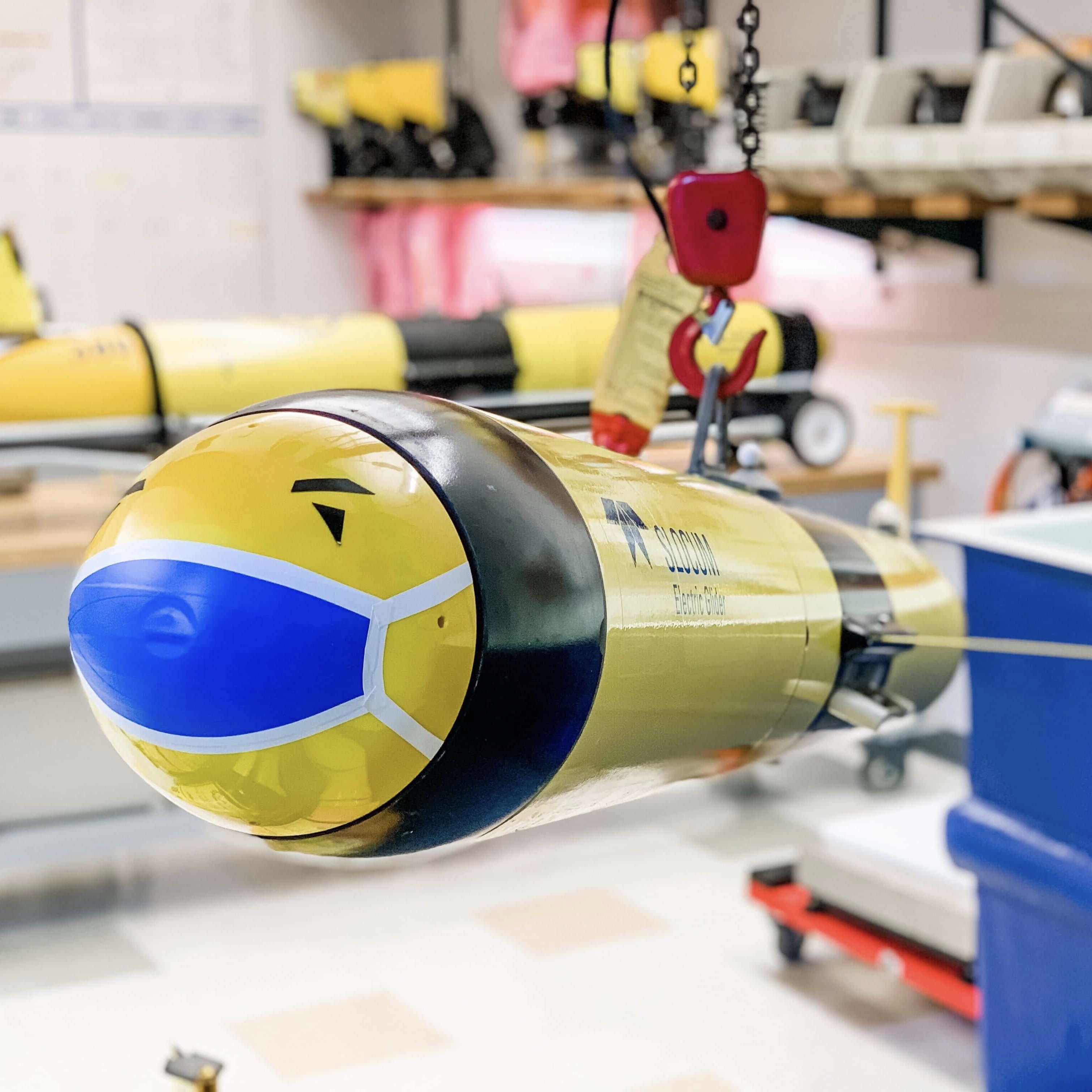
Diana Wickman
Senior Engineering Assistant II
Diana’s job involves the operation, maintenance and piloting of OOI’s fleet of Slocum Gliders and two REMUS 600 AUVs. She is based at Wood Hole Oceanographic Institution.
How did you end up at OOI? When people ask me this question I often say “by accident.” I interviewed with OOI 11 years ago in early 2009 when the program was just kicking off. I had a degree in Marine Science from the University of Connecticut and was wrapping up a four-year stint in the US Air Force as a Satellite Communications Technician – an odd combo to say the least. I applied to be an electrical engineering technician but was instead offered the job of Configuration Manager. I had spent about three years doing configuration management when the program acquired its first Slocum Gliders. I remember walking past the gliders in the hallway one day, so shiny and yellow, and I was immediately hooked. I wanted to know all about these giant “tub toys.” The rest is history.
What is the most challenging part of your job? The most matter-of-fact answer to this question is: keeping the ocean OUT of the inside of the robot, but that is only half of the challenge. The ocean, especially the areas OOI operates in, is really good at breaking things. The OOI Gliders are designed to be deployed with no hands-on human interaction for up to one year at a time. When I’m in the lab working on the gliders I cannot stop at “it is working today,” I need to constantly be thinking “will this remain working for up to a year?” It has been very challenging and also rewarding to learn a system well enough to be able to predict future failures and prevent them before they arise.
What do you enjoy most about your job? I’m only part joking when I tell people the robots are like my kids. They seem to have their own unique “personalities”; some are difficult and some are easy, some seem to love to be deployed and others seem to want to sit in the lab, some are warriors and others wave the white flag at the first sign of trouble. For me, the most rewarding part of the job is seeing the gliders succeed at their missions and come home after their long deployments. Finally getting them on the bench in the lab after a year apart is kind of surreal. I love the story each glider tells of its deployment through the engineering data it gathered at sea. In laying my hands on the vehicle again I become a detective of sorts: did the Glider have a run in with a shark, a near miss with a leak, a collision with an ice berg?
Anything else you’d like to add? Having gone from the Air Force where my particular job was 96% male dominated, to ocean engineering which is also heavily male dominated (although there are many, many brilliant female engineers and engineering technicians at WHOI to look up to), I have no idea what it’s like to work in a non-male dominated career field. Being a woman in a very heavily male dominated career field has its challenges. There have been times I have been the only woman in a meeting, or on a vessel during a cruise (and often in those cases have been the one in charge). I have experienced people make assumptions about my role on the team, or my ability to do my job due to my gender. Luckily for me I’m loud, largely oblivious, and occasionally overconfident, which has helped me break through some of those gender assumptions that may have held other women back. For these traits I both thank and blame my paternal Grandmother.
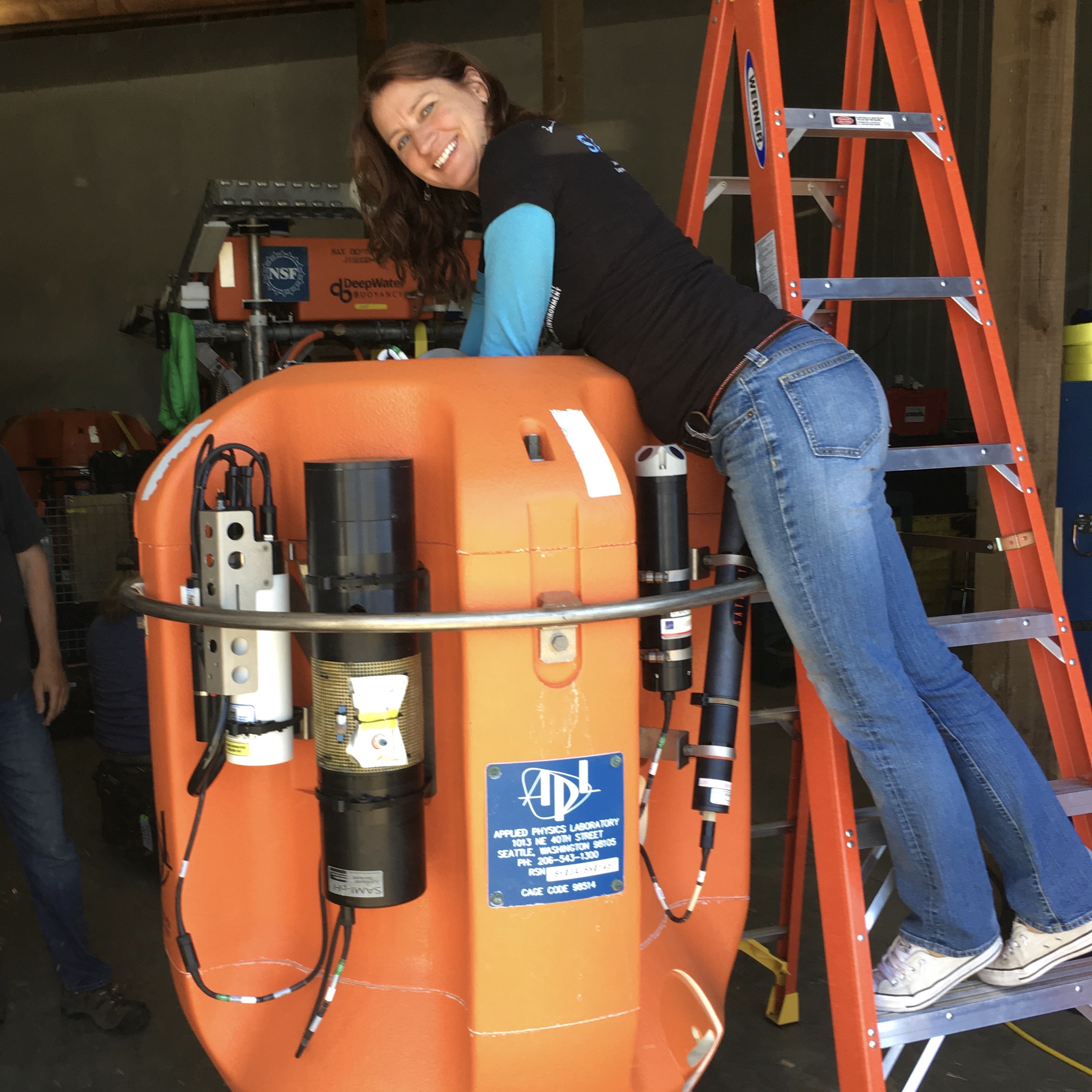
Trina Litchendorf
Oceanographer IV
Trina is part of the OOI instrument team at the University of Washington’s Applied Physics Laboratory, where they test, maintain and deploy all the commercially-produced instrumentation on the Regional Cabled Array.
What does your job entail?
There are over two dozen different types of oceanographic instruments deployed on the Regional Cabled Array – from A to Z – ADCPs (acoustic Doppler current profilers) to zooplankton sonars, and everything in between: CO2 and pH sensors, CTDs, digital still cameras, fluorometers, hydrophones, oxygen optodes, seismometers, and velocity sensors, to name a few. Every summer I go to sea off the Oregon and Washington Coast with the Woods Hole Oceanographic Institution’s Jason remotely operated vehicle (ROV) team. The ROV team recovers all of the instrument platforms that were deployed the previous year and then deploys and connects new instrument platforms. After the cruise, in the fall, we send all of the instruments recovered during the cruise, about 135 of them, to their manufacturers so the instruments can be refurbished and calibrated. The instruments start coming back from servicing in the late fall and throughout the winter. During that time, I thoroughly test the instruments to ensure they are working perfectly before they are mounted on their deployment platforms in the spring. Then they go through a round of integration testing on the platforms before the cruise. All of this careful testing ensures high-quality data and a low failure rate once the instruments are deployed. Come summer, I am back out at sea, ready to repeat the yearly maintenance cycle.
How did you end up in this job? I started working at the Applied Physics Lab as a full-time employee in 2001. The projects I have worked on since then have involved everything from lasers, gas chromatographs, and infra-red imagers to underwater vehicles, such as Seagliders and REMUS AUVs (autonomous underwater vehicles). I also have been to sea numerous times for those projects. My familiarity with various oceanographic equipment and my sea-going experience made for a natural fit for the RCA Instrument Team, which I joined in 2015.
What is the most challenging part of your position? The cruises are the most challenging. They average about 40 days, give or take, and the work is non- stop. ROV operations happen around the clock and there is always a lot to do to get the instrument platforms ready to be deployed for the next dive. Every instrument must be powered on for one final check, the platforms must be rigged properly for the ROV, and every instrument on the platform must be photographed before we send it over the side. I also run some of the dives, sitting to the left of the ROV pilot in the control van and telling him or her the order of operations and which cables to plug in. These dives can sometimes last 12 hours or more and I usually pull a few all-nighters. During cruises, we have to come into port several times to offload all the recovered gear and load the next set of equipment, which we try to accomplish in a day or two. The cruises are like marathons and require a lot of stamina. It is also hard to be away from friends and family for so long, especially during the summer when Seattle has its best weather and I’m wearing a down jacket and wool cap because it’s so overcast and cold offshore.
What do you enjoy most about your job? The cruises. As challenging as they are, the cruises also offer the greatest rewards. I enjoy working with the undergraduate students who go to sea with us for their first oceanographic cruises; their enthusiasm reminds me of my first time at sea. There are beautiful sunrises and sunsets to see, the full moon shining on the ocean is stunning, and on moonless nights, the Milky Way is visible and the stars are spectacular. Whales and dolphins occasionally swim by, and there are incredible things to see on the seafloor with the ROV’s HD (high-definition) cameras. My favorite part of the cruise every year is when we do photo-surveys of the hydrothermal vent fields and the lava flows at Axial Caldera. Seeing the interesting biology that lives at these depths and the unique lava and vent formations never gets old!
Anything else you’d like to add? In the early 2000’s, when I was an oceanography undergrad at the University of Washington, my Geological Oceanography course was taught by Drs. Deb Kelly and John Delaney. One day, Dr. Delaney gave a presentation to our class and described a revolutionary way the oceans would be studied in the future: with regional scale ocean observatories that could send data, in real time, over the Internet to scientists around the world. This was years before the Canadian NEPTUNE array, the world’s first such underwater observatory, had been deployed. I remember thinking what a fascinating idea that was. It’s amazing now to be a part of it all, going to sea alongside Dr. Kelly, and deploying the instruments that I tested on the array. I look forward to the future and a day when Dr. Delaney’s other vision is a reality: resident AUVs stationed year-round on the Regional Cabled Array, ready to be deployed immediately after an event such as an eruption at Axial Seamount.
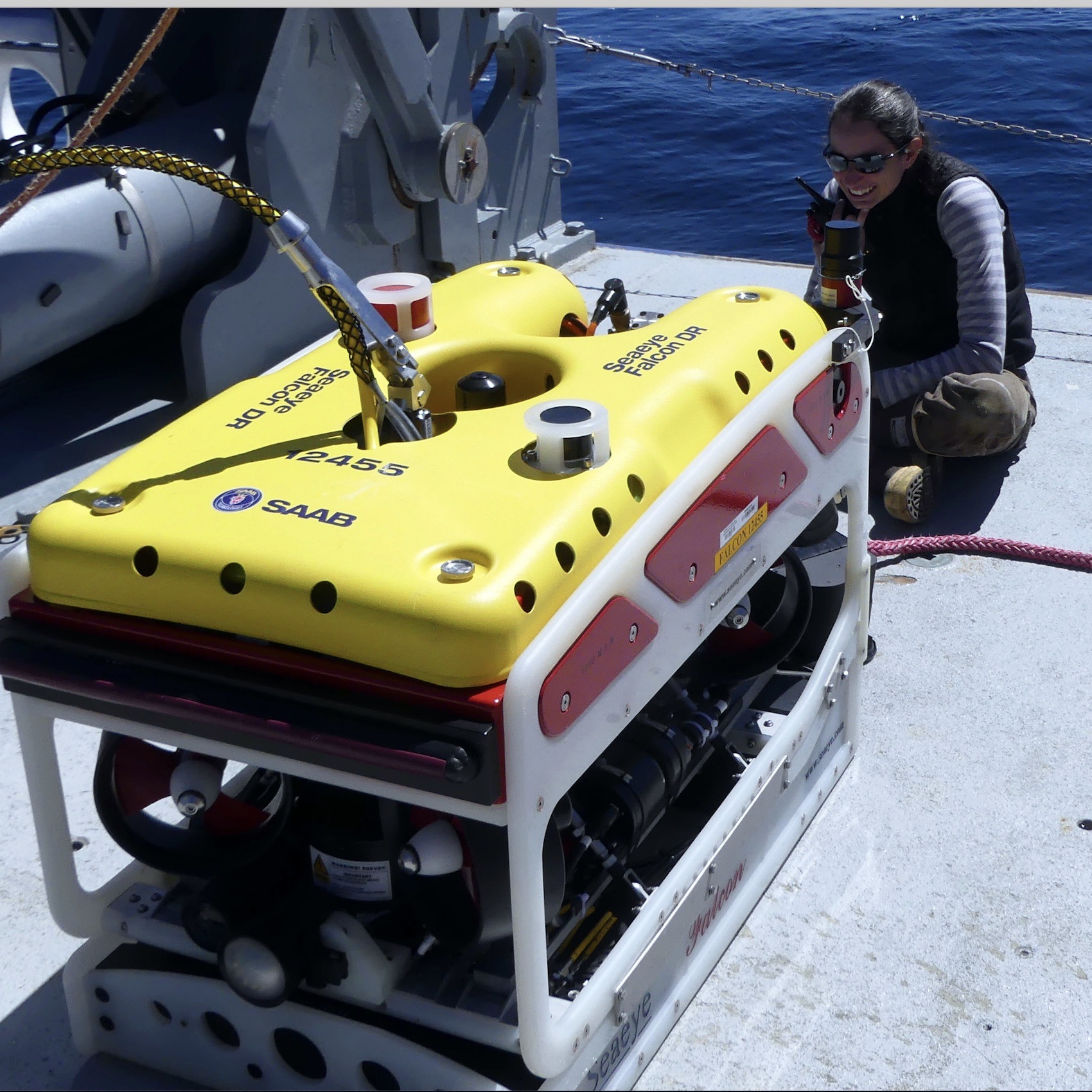
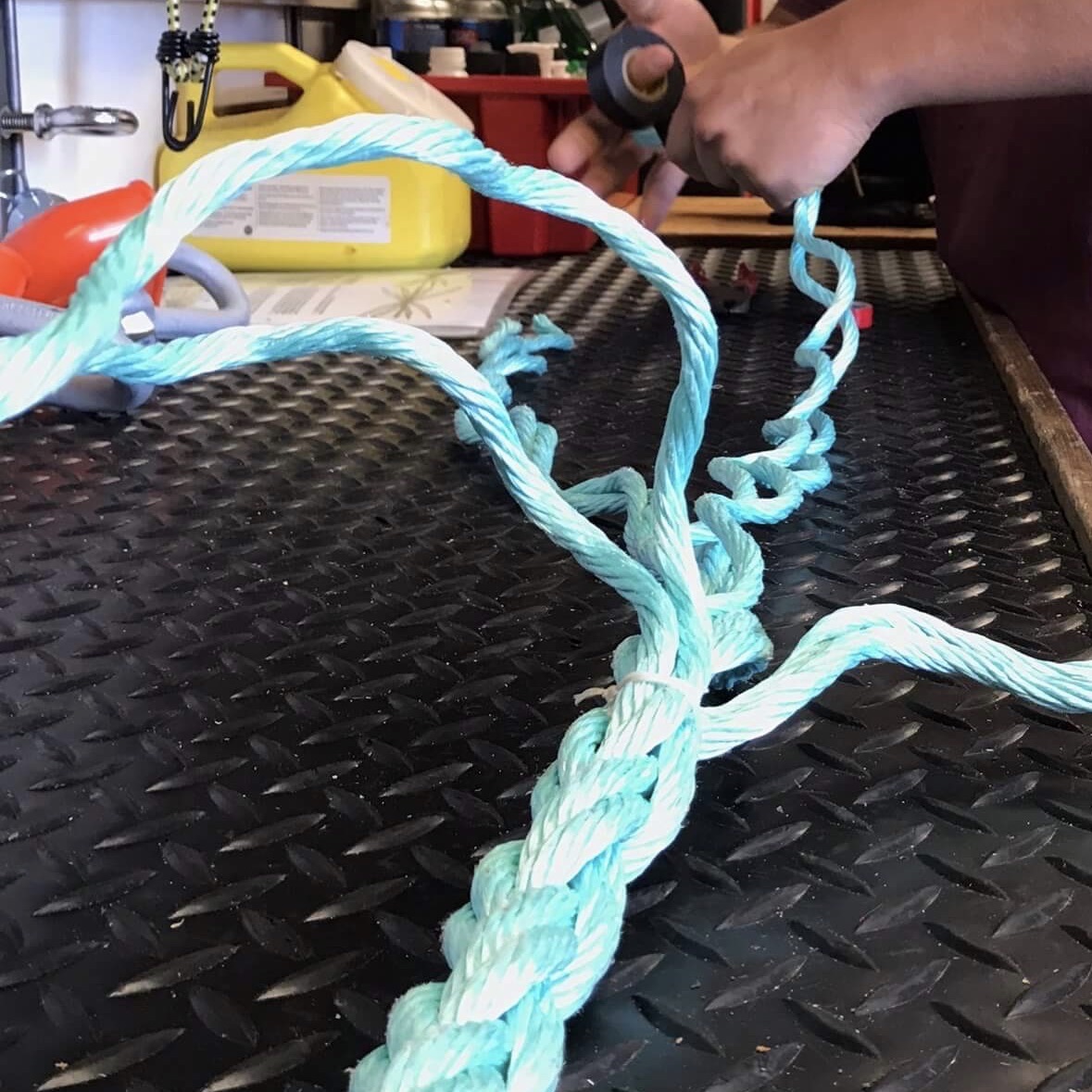
Meghan Donohue
Senior Engineering Assistant I Meghan’s job is ever-evolving. She recently changed from being a mooring tech at Wood Hole Oceanographic Institution, who served as the deck lead on multiple OOI cruises, to being a full-time OOI tech, who preps and builds the moorings for the cruises. Her new position allows her to play more with the computer side of things rather than focusing solely on mechanical issues.
How did you end up at OOI? I was a hyper-focused child who knew from a very young age that I wanted to be an oceanographer. Everything I did, from going on my first real research cruise in high school on the R/V Connecticut to studying Marine Science Physics at the University of San Diego to getting my mariners license at the Maine Maritime Academy, eventually landed me here. I worked for Scripps Institution of Oceanography as a shipboard tech, running the deck. I planned all the cruises, operated all of the oceanographic equipment and managed the computer systems on their smaller vessels. At Scripps, I met John Kemp, head of the WHOI mooring group, which eventually led to a job offer. The majority of the work I did for the WHOI mooring group was with OOI.
What is the most challenging part of your job? Balancing family and work has been my greatest challenge. Trying to rebalance that is part of the reason why I chose to change positions.
What do you enjoy most about your job? I like being able to teach the new techs and crew how to do the moorings. And I enjoy splicing—the act of weaving a piece of line together. It’s just relaxing. In addition to splicing line on the global moorings, I also splice the lines used for the Pioneer ARMS and profiler linepacks. I have made all of the ARMS linepacks with various helpers for the Pioneer cruises since the fall of 2014.
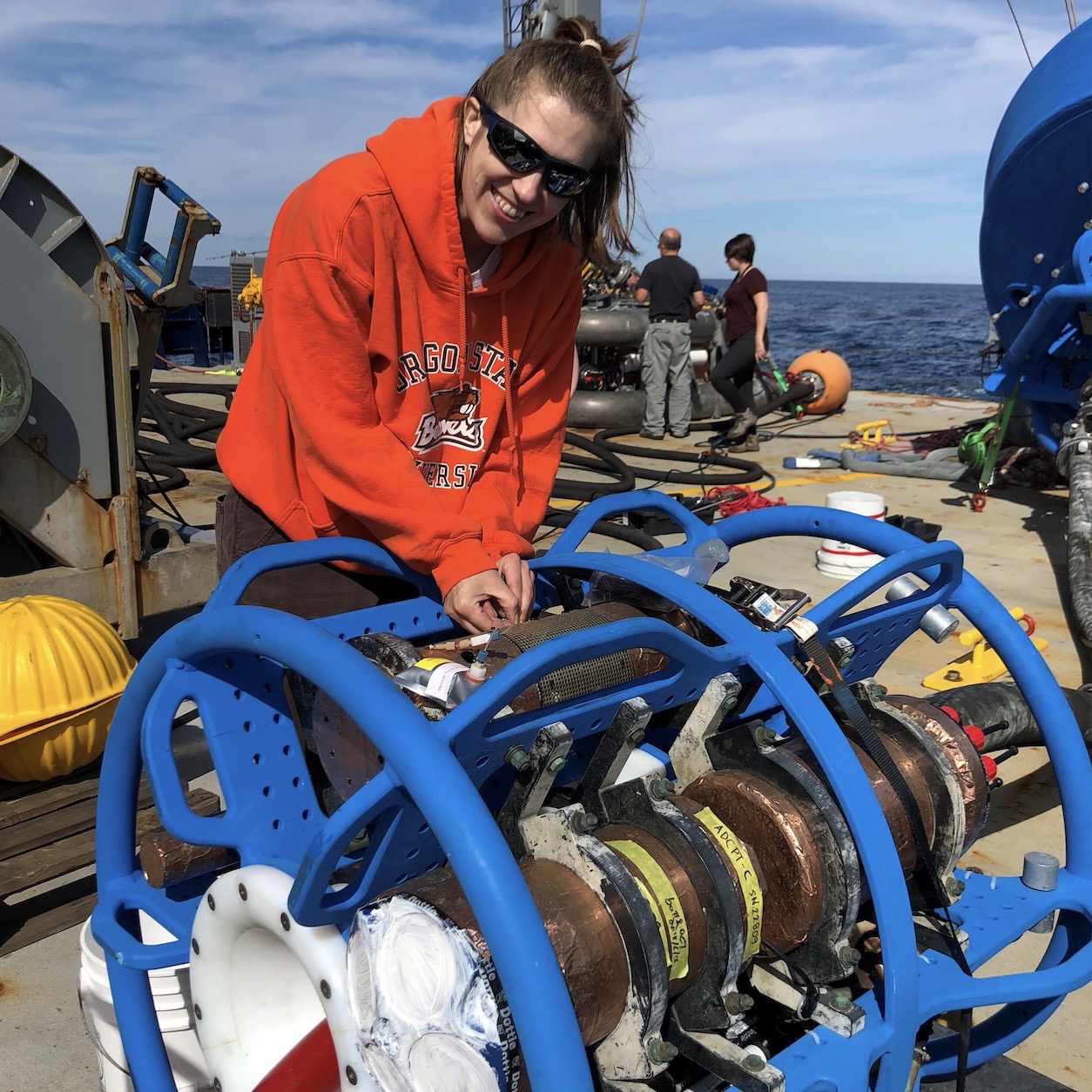
Kristin Politano
Faculty Research Assistant Kristin works with a team at Oregon State University on instrument quality control, refurbishment, and data monitoring. She also manages mooring integration for the Endurance Array, which involves building and integrating the electrical components of the moorings with the instrumentation.
How did you end up at OOI? In 2016, I joined the Oregon State University branch of PISCO (Partnership for the Interdisciplinary Studies of Coastal Oceans) as their lead mooring technician. That position allowed me to gain valuable experience with the process of building, integrating, deploying, and maintaining mooring systems. I participated in several OOI cruises while I was at PISCO and was able to meet the team of people who build and maintain the Endurance Array. When they eventually had an opening for a new position, I jumped at the chance to work with them full time.
What is the most challenging part of your job? Every new deployment brings its own set of challenges, but most of the big ones are time-related. We work closely with vendors and suppliers to stick to a timeline during builds, but it’s inevitable that delays in servicing or deliveries occur. When that happens, you have to be ready to move quickly when the parts eventually show up. Another big challenge is the lack of time to make significant improvements to the moorings. There are moments when we’re building the systems that we think “wouldn’t it be smarter it if we did it like this…” or “we could really make this more reliable if we changed that…” and often times the schedule doesn’t allow us the flexibility to make those changes.
What do you enjoy most about your job? I really enjoy problem solving, and in a lot of ways, the moorings are just like big puzzles. All the parts and pieces have to fit together perfectly for the system to function properly. Building the moorings in our shop and running them through integration and burn-in testing allows us to chase down and solve any issues that could mean the difference between a successful deployment, and a mooring that’s at sea for months with failed components. I like being able isolate and solve issues when they arise.
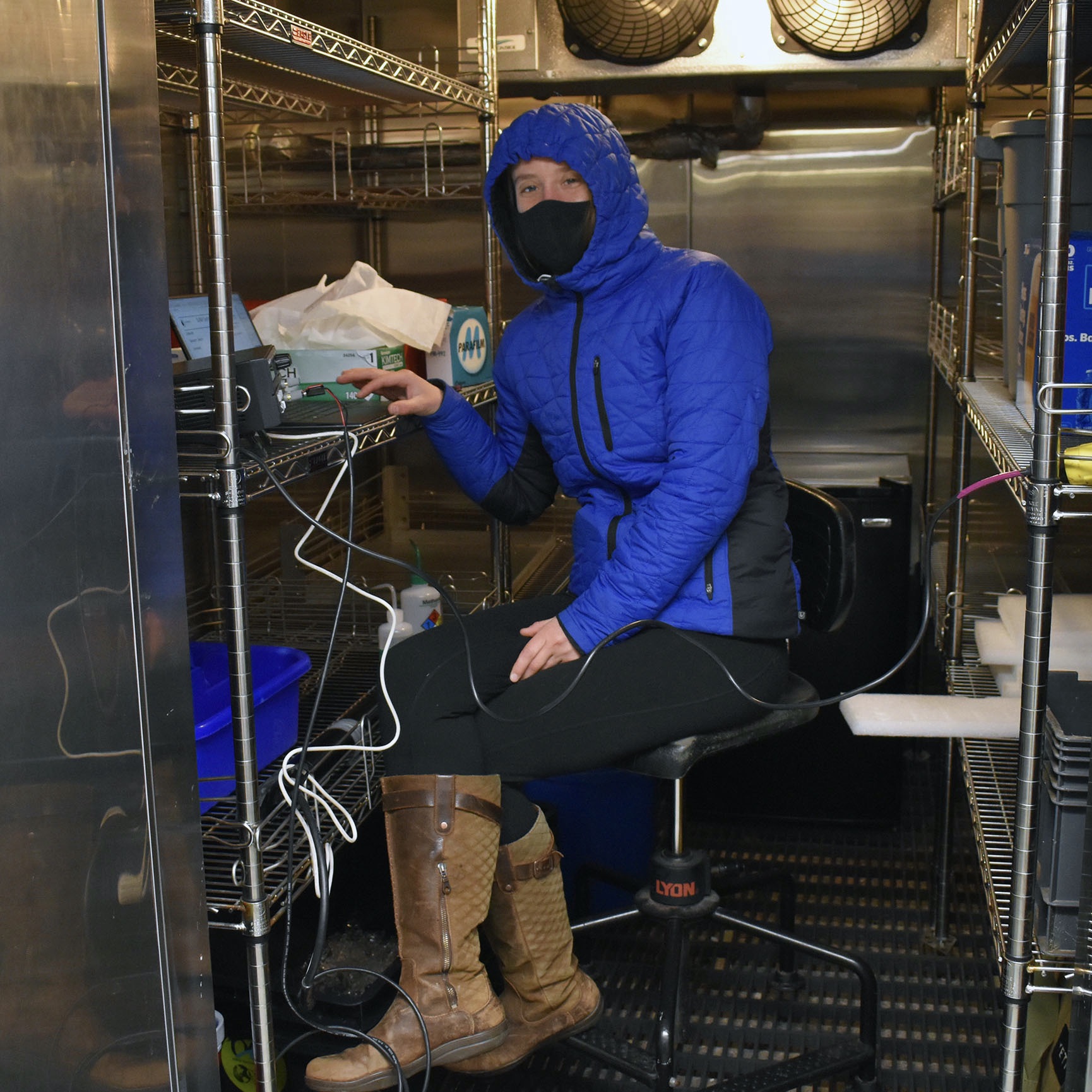
Jennifer Batryn
Engineer II
Jennifer works with (almost) all of the more than 1200 instruments that pass through the OOI program at WHOI. She is involved in the whole life cycle of the instruments, including testing, configuring, troubleshooting, deploying, data monitoring, and refurbishment.
How did you end up at OOI? I received my degree in mechanical engineering, thinking that I would end up in some sort of aeronautics or robotics field. I had never really considered a career centered around the ocean until taking part in a research program through my university. Through that program, we traveled to Malta for a month and collaborated with local archeologists, using small ROVs (remotely operated vehicles) and an AUV (autonomous underwater vehicle) to map out wells, cisterns, an underwater cave, and other features of interest around the island. Being able to work with interesting technology, travel and do field work, and collaborate with a multidisciplinary group really appealed to me, and I was sold on ocean research after that. I got involved with any ocean-based work I could afterwards, including internships at UC San Diego, National Geographic, and a summer fellowship at Woods Hole Oceanographic Institution. After college, I was thrilled to find my way back to WHOI, where I joined the OOI team.
What is the most challenging part of your position? Schedules and lack of time are the most challenging parts. Depending on how our cruise schedule line up for a particular year, it can be a surprisingly tight turnaround between recovering a set of moorings and when we need to make everything ready to deploy again. Inevitably, we have sensors and other components that come back from sea damaged. We then run into schedule conflicts with vendors and suppliers, and later discover instrument communication or sampling issues during our burn-in/testing period that need troubleshooting. The ship is going to sail regardless, which leaves very limited flexibility with timing, and sometimes there’s a real crunch period leading up to a deployment. It can also be very challenging to ensure we get good data for the entire duration of any particular deployment. The ocean is a tough environment for electronics and sensors, especially when in the water for prolonged periods. We run into problems with biofouling, physical damage from severe storms, icing, waves, or vibrations, and limitations of battery life, reagent, and other consumables.
What do you enjoy most about your job? Going to sea to support deployments and recoveries of our moorings is a nice change of pace from working in the lab and is very rewarding (if not exhausting). It’s great to see all of the work building up and burning-in of the mooring to that final end product of deployment in the ocean for six months to a year. It’s also great seeing all the data successfully come through back to shore. Long, tiring days at sea are offset by seeing all the wildlife and other natural sights in the open ocean (starry nights with no light pollution, Northern lights, stormy seas, icebergs, etc.), and traveling to different ports and experiencing different parts of the world. My dog (Teddy) was actually a Chilean street dog that I met while down in Punta Arenas preparing a mooring before a cruise. I ended up falling in love and bringing him back home with me after the cruise. Hard to beat that! It also has been really rewarding to see more people actually using OOI data, knowing that the work we are putting in is going towards the creation of a really unique, long-term data set.
Anything else you’d like to add? Going to school in such a male dominated field, it has been neat to find a core group of really smart and talented women within OOI. Everyone comes from such diverse backgrounds, and yet we all found our way to this project. Naturally the whole team is great though. It is equal parts entertaining and inspiring to work alongside everyone on our team, whether in the lab, on deck deploying a mooring, or scraping barnacles after a recovery.
Photo Credits from top
Diana Wickman headshot and glider Photo: Diana Wickman©WHOI for both
Trina Litchendorf securing oceanographic instruments on the Science Pod platform prior to a cruise. Photo: Dana Manalang
Meghan Donohue Photo: ©WHOI
Kristin Politano Photo: OSU
Jennifer Batryn in the freezer of the R/V Armstrong working on instrument calibrations at a controlled (cold) temp during the Pioneer 16 operation and maintenance cruise. Photo: Rebecca Travis©WHOI
Read More
